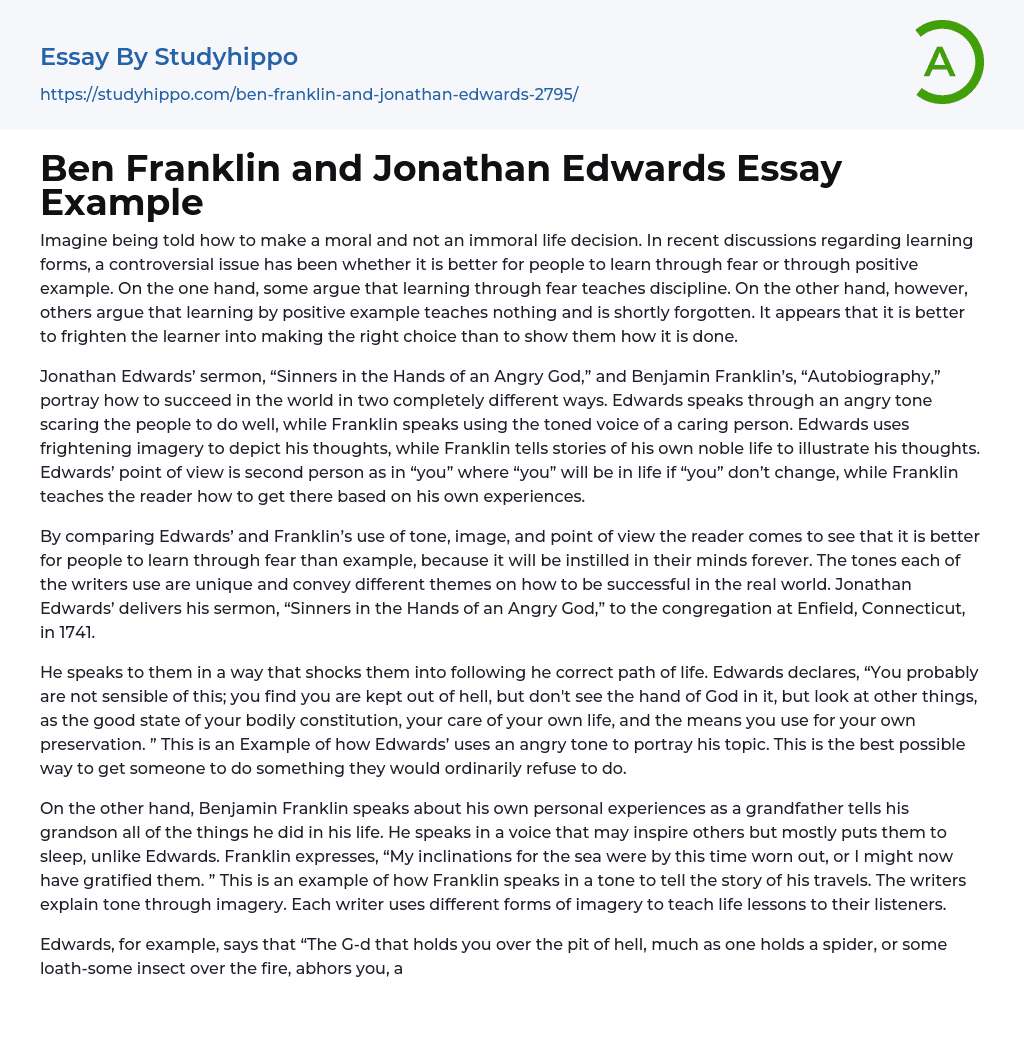The issue of moral learning methods has sparked controversy. Should people be taught through fear or positive example? Some argue that fear teaches discipline, while others believe positive examples are quickly forgotten. Ultimately, it seems that instilling fear is more effective than simply demonstrating the right choice.
Both Jonathan Edwards’ sermon, "Sinners in the Hands of an Angry God," and Benjamin Franklin’s "Autobiography" present contrasting approaches to achieving success in the world. Edwards adopts a fearful tone, aiming to frighten people into behaving well, whereas Franklin adopts a caring tone. Edwards employs terrifying imagery to convey his ideas, while Franklin shares stories from his own noble life to illustrate his points. Edwards employs a second-person perspective, addressing the audience directly as "you" and warning of the co
...nsequences if they do not change. In contrast, Franklin imparts lessons on how to achieve success based on his own experiences.
Comparing the tone, image, and point of view used by Edwards and Franklin, it becomes evident that learning through fear is more effective than learning through example. This is because fear leaves a lasting impression on the mind. The tones employed by both writers are distinct, and they convey different ideas about achieving success in the real world. In 1741, Jonathan Edwards delivered his sermon titled "Sinners in the Hands of an Angry God" to the Enfield congregation in Connecticut.
Edwards shocks his audience into following the correct path of life by speaking to them in a way that is meant to shock them. He argues that they may not be aware of it, but they are being kept out of hell by the hand of God, not by their ow
efforts or circumstances. Edwards' angry tone is evident in his declaration that they mistakenly attribute their salvation to their bodily constitution and self-preservation efforts. This shocking and angry approach is effective in compelling individuals to do something they would otherwise refuse to do.
Benjamin Franklin, in contrast, shares his personal experiences as a grandfather recounting his life to his grandson. Although his voice may inspire some, it mostly tends to lull them to sleep, unlike Edwards. Franklin reveals, "My inclinations for the sea were by this time worn out, or I might now have gratified them." This illustrates how Franklin narrates his travels in a storytelling tone. Both authors convey tone through imagery, employing various forms of imagery to impart life lessons to their audience.
Edwards explains that G-d "abhors" and is "dreadfully provoked" towards individuals. His anger towards them burns like fire, as He sees them deserving nothing but to be thrown into the fire. However, it is solely His intervention that prevents them from falling into the fire every moment. Through vivid imagery, Edwards instructs churchgoers on the potential of easily ending up in hell. The analogy of G-d holding a person, akin to holding an insect, resonates powerfully and elicits deep contemplation.
Franklin's autobiography also includes some strong images, although they are not as vivid as Edwards'. Franklin, for instance, mentions a damaging squall that tore apart their worn-out sails and prevented their progress in the bay. These words from our founding father aim to depict the fear he felt during his difficult trip to New York, but they lack emotional intensity. Infusing emotion into the imagery would enhance its portrayal. Utilizing imagery is an
effective means of conveying viewpoint. Each writer employs a distinct point of view to impart a lesson to the reader.
Edwards and Franklin have contrasting styles of speech. Edwards addresses the audience directly, using the second person and pointing out their wickedness, saying "Your wickedness makes you as it were heavy as lead." His intention is to emphasize that it is the churchgoers who need to address their problems, not him. On the other hand, Franklin adopts a first-person perspective, sharing the lessons he has learned in his own life. He recounts a situation where he asserted his freedom, assuming that the other person would not produce new indentures. Franklin does not aim to instruct readers; he simply reflects on his own actions in that particular circumstance.
After closely comparing Jonathan Edwards' "Sinners in the Hands of an Angry G-d" and Benjamin Franklin's "Autobiography," it becomes clear to the reader that the use of fear and anger as teaching tools is more impactful than relying on love and positive role models. This conclusion is drawn from an analysis of each author's tone, imagery, and perspective. Edwards took a unique approach to teaching that may have been unconventional but proved to be highly effective. Therefore, it can be argued that Edwards' writing style is superior in imparting knowledge to the uninterested minds of contemporary society.
- Book Summary essays
- Metaphor essays
- Reader essays
- Rhyme essays
- Literary devices essays
- Villain essays
- Books essays
- Genre essays
- Literary Criticism essays
- Writer essays
- Protagonist essays
- Simile essays
- Poem essays
- Book Report essays
- Book Review essays
- Greek Mythology essays
- Plot essays
- Tragic Hero essays
- Coming of Age essays
- Play essays
- Rhetoric essays
- Rhetorical Question essays
- Translation essays
- Understanding essays
- Reason essays
- Character essays
- Letter essays
- American Literature essays
- Literature Review essays
- Utopia essays
- Poetry Analysis essays
- Dante's Inferno essays
- Between The World and Me essays
- Incidents in The Life of a Slave Girl essays
- Flowers for Algernon essays
- Myth essays
- Everyday Use essays
- Boo Radley essays
- Genesis essays
- Richard iii essays
- Alice in Wonderland essays
- On the road essays
- Ozymandias essays
- The Nightingale essays
- Holden Caulfield essays
- Animal Farm essays
- 1984 essays
- A Hanging essays
- Shooting An Elephant essays
- A Tale Of Two Cities essays




